Impact of Climate Change on the Winter Wheat Productivity Under Varying Climate Scenarios in the Loess Plateau: An APSIM Analysis (1961–2100)
Abstract
1. Introduction
2. Materials and Methods
2.1. Description of the Study Area
2.2. Data Collection
2.3. Model Configuration Parameter
2.4. Change Trend of Meteorological Data
3. Results
3.1. Spatial Distribution of Historical Meteorological Resources
3.2. Change Characteristics of Meteorological Resources Under Future Climate Scenarios
3.3. Changes in Yield Under Rainfed Conditions in Future Climate Scenarios
3.3.1. Calibration and Validation of Simulated Yield with the Field Experiment Data
3.3.2. Potential Yield of Winter Wheat Under Rainfed Conditions Under Future Climate Scenarios
4. Discussion
4.1. Effects of Climate Change on Agro-Climatic Resources Under Different Climate Scenarios
4.2. Effects of Climate Change on Potential Yield of Winter Wheat Under Future Climate Scenarios
5. Conclusions
- (1)
- Agro-climatic resources in the Loess Plateau have undergone significant changes during 1961–2014 and 2015–2100, inevitably influencing the agricultural production and planting in the region. Correlation analysis showed that precipitation during the winter wheat growing period, as well as temperature, were positively correlated with both actual and climatic yield.
- (2)
- The average potential yields were compared under three climate scenarios, and the results indicate that S585 > S245 > current. The predicted potential yield fluctuates, with both the S245 and S585 scenarios being significantly larger than the current scenario.
- (3)
- Climate change has a profound impact on agricultural production, necessitating the consideration of more climate factors in future agricultural policy formulation. In conclusion, this study provides valuable insights for exploring effective agricultural management measures in the Loess Plateau under evolving climatic conditions.
Author Contributions
Funding
Data Availability Statement
Acknowledgments
Conflicts of Interest
References
- Patrick, L.; Jäckel, G.; Tingem, R.M.; Kunstmann, H. Impact of climate change on agricultural productivity under rainfed conditions in Cameroon—A method to improve attainable crop yields by planting date adaptations. Agric. For. Meteorol. 2010, 150, 1258–1271. [Google Scholar] [CrossRef]
- Li, Z.; Yang, P.; Tang, H.; Wu, W.; Yin, H.; Liu, Z.; Zhang, L. Response of maizephenology to climate warming in Northeast China between 1990 and 2012. Reg. Environ. Change 2014, 14, 39–48. [Google Scholar] [CrossRef]
- Li, X.; Gong, J.D. Effects of different ridge: Furrow ratios and supplemental irrigation on crop production in ridge and furrow rainfall harvesting system with mulches. Agric. Water Manag. 2002, 54, 243–254. [Google Scholar] [CrossRef]
- Duan, J.J.; Wang, X.L.; Gao, Z.L. Dynamics and trends analysis of annual precipitation in the Loess Plateau for 50 years. J. Soil Water Conserv. 2009, 23, 143–146. [Google Scholar] [CrossRef]
- Zhang, Y.H.; Liang, K.; Liu, C.M. Time distribution pattern and spatial heterogeneity of hourly scale event-based extreme precipitation in China. J. Hydrol. 2023, 622 Pt A, 129712. [Google Scholar] [CrossRef]
- Zhang, W.X.; Kalli, F.; Wu, P.L.; Zhou, T.; Chadwick, R.; Marzin, C.; Rostron, J.; Sexton, D. Increasing precipitation variability on daily-to-multiyear timescales in a warmer world. Sci. Adv. 2021, 7, eabf8021. [Google Scholar] [CrossRef]
- Gu, C.J.; Mu, X.M.; Gao, P. Characteristics of temporal variation in precipitation and temperature in the Loess Plateau from 1961 to 2014. J. Arid Land Resour. Environ. 2017, 31, 136–143. [Google Scholar] [CrossRef]
- Guo, E.L.; Wang, Y.F.; Jirigala, B.; Jin, E. Spatiotemporal variations of precipitation concentration and their potential links to drought in mainland China. J. Clean. Prod. 2020, 267, 122004. [Google Scholar] [CrossRef]
- Lenka, N.K.; Lenka, S.; Yashona, D.S.; Jat, D. Elevated temperature and low nitrogen partially offset the yield, evapotranspiration, and water use efficiency of winter wheat under carbon dioxide enrichment. Agric. Water Manag. 2021, 250, 106856. [Google Scholar] [CrossRef]
- Bouroncle, C.; Müller, A.; Giraldo, D.; Rios, D.; Imbach, P.; Girón, E.; Portillo, F.; Boni, A.; van Etten, J.; Ramirez-Villegas, J. A systematic approach to assess climate information products applied to agriculture and food security in Guatemala and Colombia. Clim. Serv. 2019, 16, 100137. [Google Scholar] [CrossRef]
- Yang, X.; Li, Z.; Cui, S.; Cao, Q.; Deng, J.; Lai, X.; Shen, Y. Cropping system productivity and evapotranspiration in the semiarid Loess Plateau of China under future temperature and precipitation changes: An APSIM-based analysis of rotational vs. continuous systems. Agric. Water Manag. 2020, 229, 105959. [Google Scholar] [CrossRef]
- Gao, Z.Z.; Wang, C.; Zhao, J.C. Adopting different irrigation and nitrogen management based on precipitation year types balances winter wheat yields and greenhouse gas emissions. Field Crops Res. 2022, 280, 108484. [Google Scholar] [CrossRef]
- Qi, Z.; Feng, H.; Zhao, Y.; Zhang, T.; Zhang, Z. Spatial distribution and simulation of soil moisture and salinity undermulched drip irrigation combined with tillage in an arid salineirrigation district, northwest China. Agric. Water Manag. 2018, 201, 219–231. [Google Scholar] [CrossRef]
- Meisinger, J.J.; Palmer, R.E.; Timlin, D.J. Effects of tillage practices on drainage and nitrate leaching from winter wheat in the Northern Atlantic Coastal-Plain USA. Soil Tillage Res. 2015, 151, 18–27. [Google Scholar] [CrossRef]
- Ali, S.; Xu, Y.Y.; Jia, Q.M.; Ma, X.C.; Ahmad, I.; Adnan, M.; Gerard, R.; Ren, X.L.; Zhang, P.; Cai, T.; et al. Interactive effects of plastic film mulching with supplemental irrigation on winter wheat photosynthesis, chlorophyll fluorescence and yield under simulated precipitation conditions. Agric. Water Manag. 2018, 207, 1–14. [Google Scholar] [CrossRef]
- Zhang, L.L.; Feng, H.; Dong, Q.G.; Jin, N.; Zhang, T. Mapping irrigated and rainfed wheat areas using high spatial-temporal resolution data generated by MODIS and Landsat. J. Appl. Remote Sens. 2019, 12, 046023. [Google Scholar] [CrossRef]
- Lobell, D.B.; Burke, M.B.; Tebaldi, C.; Mastrandrea, M.D.; Falcon, W.P.; Naylor, R.L. Prioritizing climate change adaptation needs for food security in 2030. Science 2008, 319, 607–610. [Google Scholar] [CrossRef]
- Farrell, A.D.; Deryng, D.; Neufeldt, H. Modelling adaptation and transformative adaptation in cropping systems: Recent advances and future directions. Curr. Opin. Environ. Sustain. 2023, 61, 101265. [Google Scholar] [CrossRef]
- Sun, S.K.; Li, C.; Wu, P.T.; Zhao, X.N.; Wang, Y.B. Evaluation of agricultural water demand under future climate change scenarios in the Loess Plateau of Northern Shaanxi, China. Ecol. Indic. 2018, 84, 811–819. [Google Scholar] [CrossRef]
- Dettori, M.; Cesaraccio, C.; Duce, P. Simulation of climate change impacts on production and phenology of durum wheat in Mediterranean environments using CERES-Wheat model. Field Crops Res. 2017, 206, 43–53. [Google Scholar] [CrossRef]
- Wang, X.H.; Philippe, C.; Laurent, L.; Ruget, F.; Vuichard, N.; Viovy, N.; Zhou, F.; Chang, J.; Wu, X.; Zhao, H.; et al. Management outweighs climate change on affecting length of rice Growing period for early rice and single rice in China during 1991–2012. Agric. For. Meteorol. 2017, 233, 1–11. [Google Scholar] [CrossRef]
- Hou, Y.Y.; He, L.; Jin, N.; Zheng, C.L.; Liu, W.; Zhang, L. Establishment and application of crop growth simulating and monitoring system in China. Trans. Chin. Soc. Agric. Eng. (Trans. CSAE) 2018, 34, 165–175, (In Chinese with English abstract). [Google Scholar] [CrossRef]
- Mark, W.Y.; Ewen, M.; Geoffrey, R.S. Environmental risk assessment of blight-resistant potato: Use of a crop model to quantify nitrogen cycling at scales of the field and cropping system. Environ. Sci. Pollut. Res. 2017, 24, 21434–21444. [Google Scholar] [CrossRef]
- Blanc, É. Statistical emulators of maize, rice, soybean and wheat yields from global gridded crop models. Agric. For. Meteorol. 2017, 236, 145–161. [Google Scholar] [CrossRef]
- Yang, Q.; Zuo, H.; Xiao, X.; Wang, S.; Chen, B.; Chen, J. Modelling the effects of plastic mulch on water, heat and CO2 fluxes over cropland in an arid region. J. Hydrol. 2012, 452, 102–118. [Google Scholar] [CrossRef]
- Yao, Y.; Lu, Y.H.; Liu, S.N. Modelling the impact of climate change and tillage practices on soil CO2 emissions from dry farmland in the Loess Plateau of China. Ecol. Model. 2023, 478, 110276. [Google Scholar] [CrossRef]
- Malone, R.W.; Nolan, B.T.; Ma, L.; Kanwar, R.S.; Pederson, C.; Heilman, P. Effects of tillage and application rate on atrazine transport to subsurface drainage: Evaluation of RZWQM using a six-year field study. Agric. Water Manag. 2014, 132, 10–22. [Google Scholar] [CrossRef]
- Ma, L.W.; Lajpat, R. Mathematical modeling for system analysis in agricultural research: Karel, D. Vohnout, Elsevier Science, Amsterdam, The Netherlands, 2003, 452 pp. ISBN: 0-444-51268-3. Agric. Syst. 2004, 81, 273–274. [Google Scholar] [CrossRef]
- Chimonyo, V.G.P.; Modi, A.T.; Mabhaudhi, T. Simulating yield and water use of a sorghum–cowpea intercrop using APSIM. Agric. Water Manag. 2016, 177, 317–328. [Google Scholar] [CrossRef]
- Gaydon, D.S.; Singh, B.; Wang, E.; Poulton, P.L.; Ahmad, B.; Ahmed, F.; Akhter, S.; Ali, I.; Amarasingha, R.; Chaki, A.K.; et al. Evaluation of the APSIM model in cropping systems of Asia. Field Crops Res. 2017, 204, 52–75. [Google Scholar] [CrossRef]
- Zhou, Z.Q.; Ding, Y.B.; Fu, Q.; Wang, C.; Wang, Y.; Cai, H.J.; Liu, S.N.; Huang, S.Z.; Shi, H.Y. Insights from CMIP6 SSP scenarios for future characteristics of propagation from meteorological drought to hydrological drought in the Pearl River Basin. Sci. Total Environ. 2023, 899, 165618. [Google Scholar] [CrossRef] [PubMed]
- Hurtt, G.C.; Chini, L.; Sahajpal, R.; Frolking, S.; Bodirsky, B.L.; Calvin, K.; Doelman, J.C.; Fisk, J.; Fujimori, S.; Klein Goldewijk, K.; et al. Harmonization of global land use change and management for the period 850–2100 (LUH2) for CMIP6. Geosci. Model Dev. 2020, 13, 5425–5464. [Google Scholar] [CrossRef]
- Popping, A.; Calvin, K.; Fujimori, S.; Havlik, P.; Humpenöder, F.; Stehfest, E.; Bodirsky, B.L.; Dietrich, J.P.; Doelmann, J.C.; Gusti, M.; et al. Land-use futures in the shared socio-economic pathways. Glob. Environ. Change 2017, 42, 331–345. [Google Scholar] [CrossRef]
- Wang, J.; Ghimire, R.; Fu, X.; Sainju, U.M.; Liu, W. Straw mulching increases precipitation storage rather than water use efficiency and dryland winter wheat yield, Contents lists available at Science Direct. Agric. Water Manag. 2018, 106, 95–101. [Google Scholar] [CrossRef]
- Wang, Y.X.; Xu, Y.R.; Guo, Q.; Zhang, P.; Cai, T.; Jia, Z.K. Advantages of deep fertilizer placement in environmental footprints and net ecosystem economic benefits under the variation of precipitation year types from winter wheat fields. Field Crops Res. 2023, 303, 109142. [Google Scholar] [CrossRef]
- Gong, X.W.; Li, Y.Q.; Wang, X.Y.; Zhang, Z.S.; Lian, J.; Ma, L.; Chen, Y.; Li, M.Y.; Si, H.T.; Cao, W.J. Quantitative assessment of the contributions of climate change and human activities on vegetation degradation and restoration in typical ecologically fragile areas of China. Ecol. Indic. 2022, 144, 109536. [Google Scholar] [CrossRef]
- Malakouti, S.M. Utilizing time series data from 1961 to 2019 recorded around the world and machine learning to create a Global Temperature Change Prediction Model. Case Stud. Chem. Environ. Eng. 2023, 7, 100312. [Google Scholar] [CrossRef]
- Kirchmeier-Young, M.C.; Wan, H.; Zhang, X.B. Using a model comparison to support the interpretation of extreme event attribution. Weather Clim. Extrem. 2022, 36, 100444. [Google Scholar] [CrossRef]
- Gampe, D.; Zscheischler, J.; Reichstein, M.; O’Sullivan, M.; Smith, W.K.; Sitch, S.; Buermann, W. Increasing impact of warm droughts on northern ecosystem productivity over recent decades. Nat. Clim. Change 2021, 11, 772–779. [Google Scholar] [CrossRef]
- Liu, Y.; Li, S.; Chen, F.; Yang, S.; Chen, X. Soil water dynamics and water use efficiency in spring maize (Zea mays L.) fields subjected to different water management practices on the Loess Plateau, China. Agric. Water Manag. 2010, 97, 769–775. [Google Scholar] [CrossRef]
- Tao, F.; Zhang, S.; Zhang, Z. Spatiotemporal changes of wheat phenology in China under the effects of temperature, day length and cultivar thermal characteristics. Eur. J. Agron. 2012, 43, 201–212. [Google Scholar] [CrossRef]
- Zhang, T.; Huang, Y.; Yang, X. Climate warming over the past three decadeshas shortened rice growth duration in China and cultivar shifts have furtheraccelerated the process for late rice. Glob. Change Biol. 2013, 19, 563–570. [Google Scholar] [CrossRef]
- Oteros, J.; García-Mozo, H.; Botey, R.; Mestre, A.; Galán, C. Variations in cereal crop phenology in Spain over the last twenty-six years (1986–2012). Clim. Change 2015, 130, 545–558. [Google Scholar] [CrossRef]
- Mo, F.; Sun, M.; Liu, X.Y.; Wang, J.Y.; Zhang, X.C.; Ma, B.L.; Xiong, Y.C. Phenological responses of spring wheat and maize to changes in crop management and rising temperatures from 1992 to 2013 across the loess plateau. Field Crops Res. 2016, 196, 337–347. [Google Scholar] [CrossRef]
- Zhang, Y.G.; Liu, F.; Wang, X.L.; Zhou, J.H.; Liu, M.C.; Zhang, J.T.; Wang, W.T.; Li, D.Q. The impact investigation and adaptation strategy analysis of climate change on nature reserve in China. Acta Ecol. Sin. 2014, 34, 106–109. [Google Scholar] [CrossRef]
- Ren, S.; Guo, B.; Wu, X.; Zhang, L.; Wang, J. Winter wheat planted area monitoring and yield modeling using MODIS data in the Huang-Huai-Hai Plain, China. Comput. Electron. Agric. 2021, 182, 106049. [Google Scholar] [CrossRef]
- Hallegatte, S.; Vogt-Schilb, A.; Rozenberg, J.; Bangalore, M.; Beaudet, C. From poverty to disaster and back: A review of the literature. Econ. Disasters Clim. Change 2020, 4, 223–247. [Google Scholar] [CrossRef]
- Opoku Mensah, S.; Akanpabadai, T.A.B.; Diko, S.K.; Okyere, S.A.; Benamba, C.; Chandrakanth, M.G.; Rajasekhar, D.; Inbanathan, A.; Madheswaran, S. Prioritization of climate change adaptation strategies by smallholder farmers in semi-arid savannah agro-ecological zones: Insights from the Talensi District, Ghana. J. Soc. Econ. Dev. 2022, 25, 232–258. [Google Scholar] [CrossRef]
- Kogo, B.K.; Kumar, L.; Koech, R. Climate change and variability in Kenya: A review of impacts on agriculture and food security. Environ. Dev. Sustain. 2021, 23, 23–43. [Google Scholar] [CrossRef]
- Gourdji, S.; Läderach, P.; Valle, A.M.; Martinez, C.Z.; Lobell, D.B. Historical climate trends, deforestation, and maize and bean yields in Nicaragua. Agric. For. Meteorol. 2015, 200, 270–281. [Google Scholar] [CrossRef]
- Lobell, D.B.; Schlenker, W.; Costa-Roberts, J. Climate trends and globalcrop production since 1980. Science 2011, 333, 616–620. [Google Scholar] [CrossRef] [PubMed]
- Rowhani, P.; Lobell, D.B.; Linderman, M.; Ramankutty, N. Climate variability and crop production in Tanzania. Agric. For. Meteorol. 2011, 151, 449–460. [Google Scholar] [CrossRef]
- Jiang, T.C.; Wang, B.; Duan, X.N.; Liu, D.L.; He, J.Q.; He, L.; Jin, N.; Feng, H.; Yu, Q. Prioritizing agronomic practices and uncertainty assessment under climate change for winter wheat in the loess plateau, China. Agric. Syst. 2023, 212, 103770. [Google Scholar] [CrossRef]


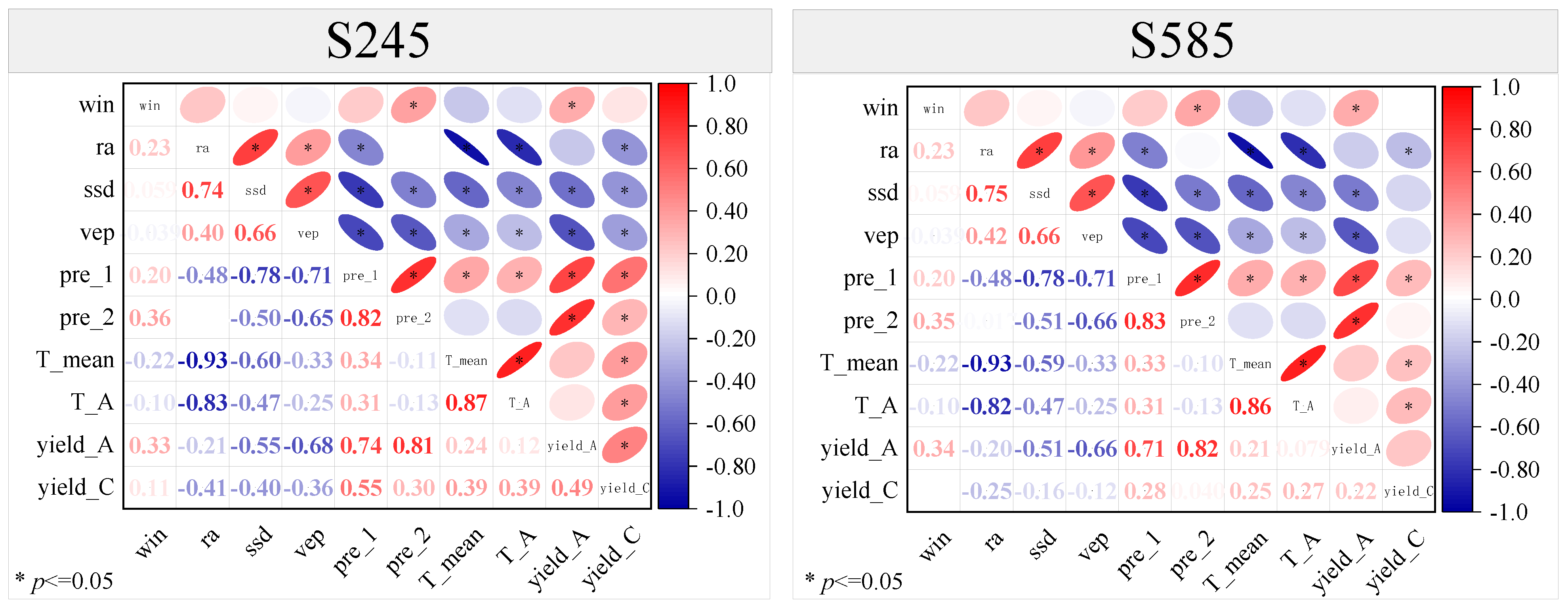
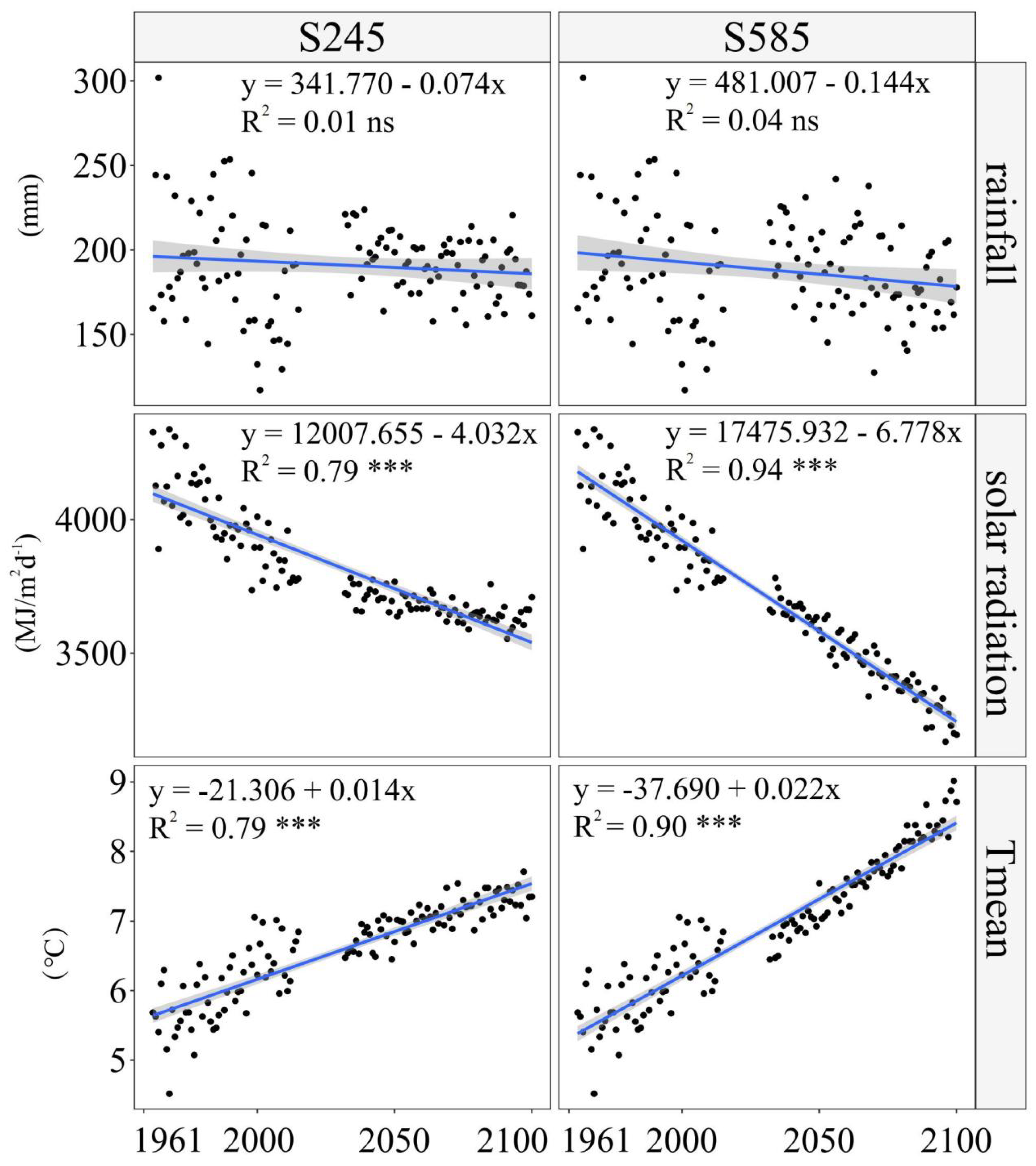
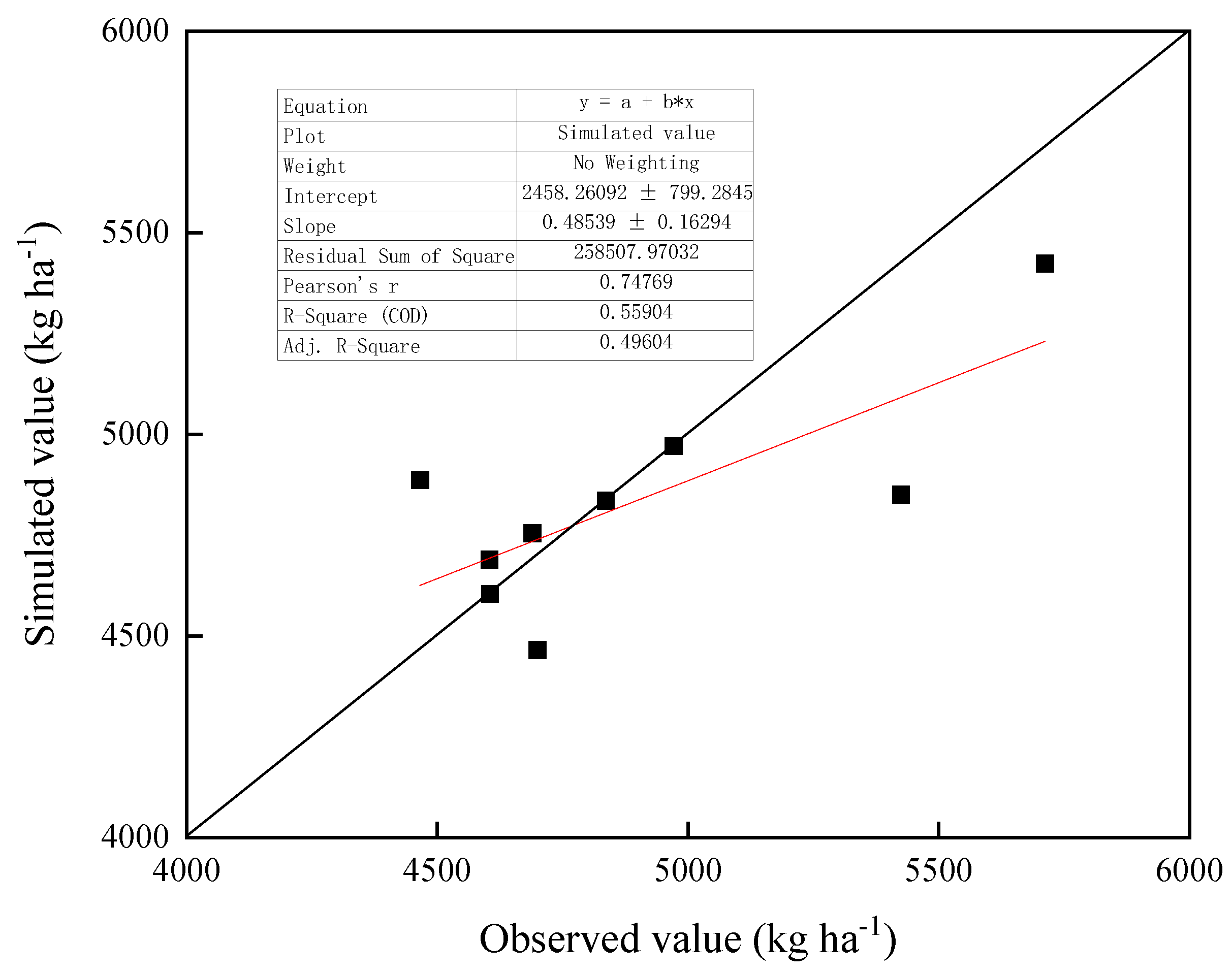
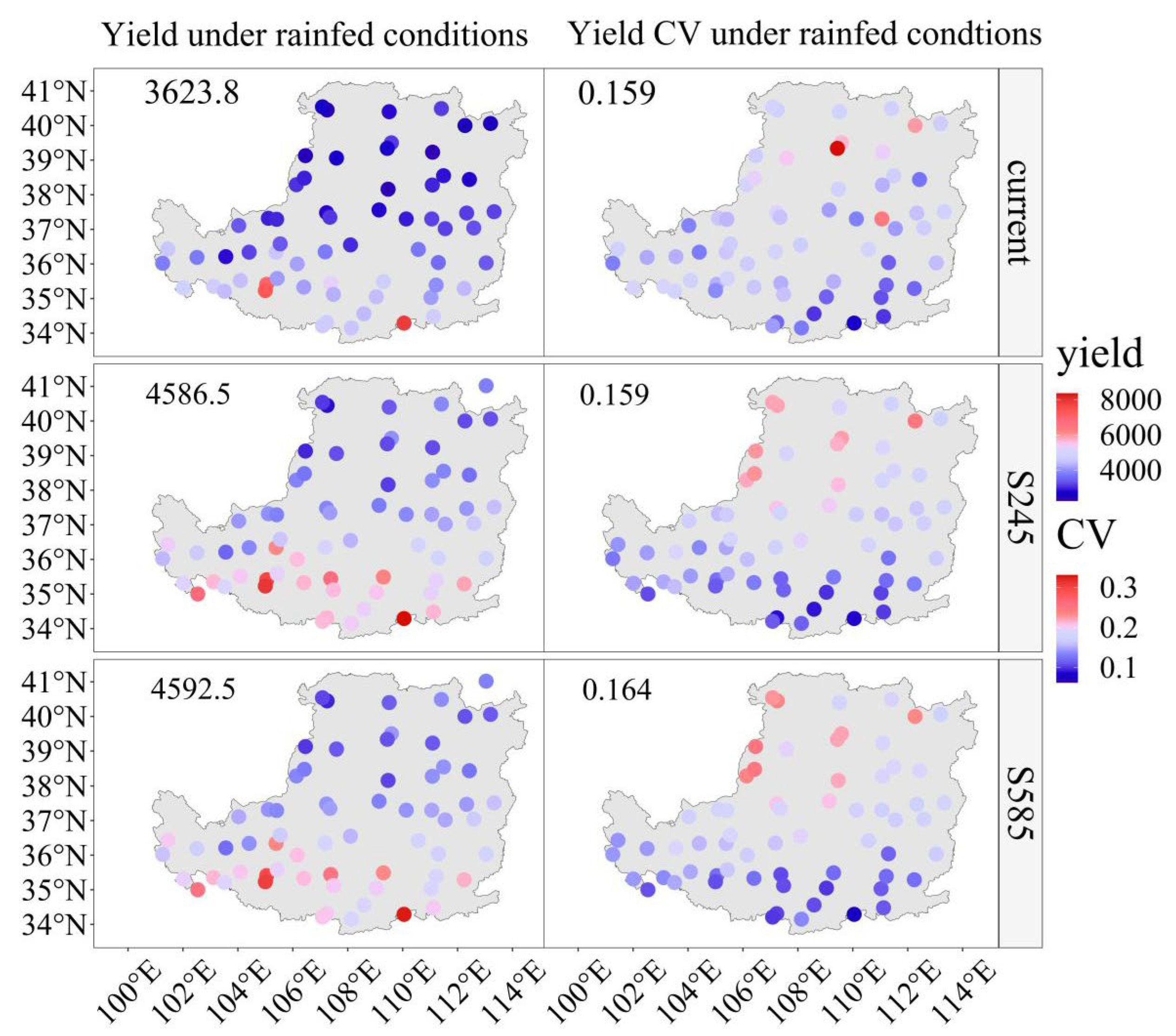

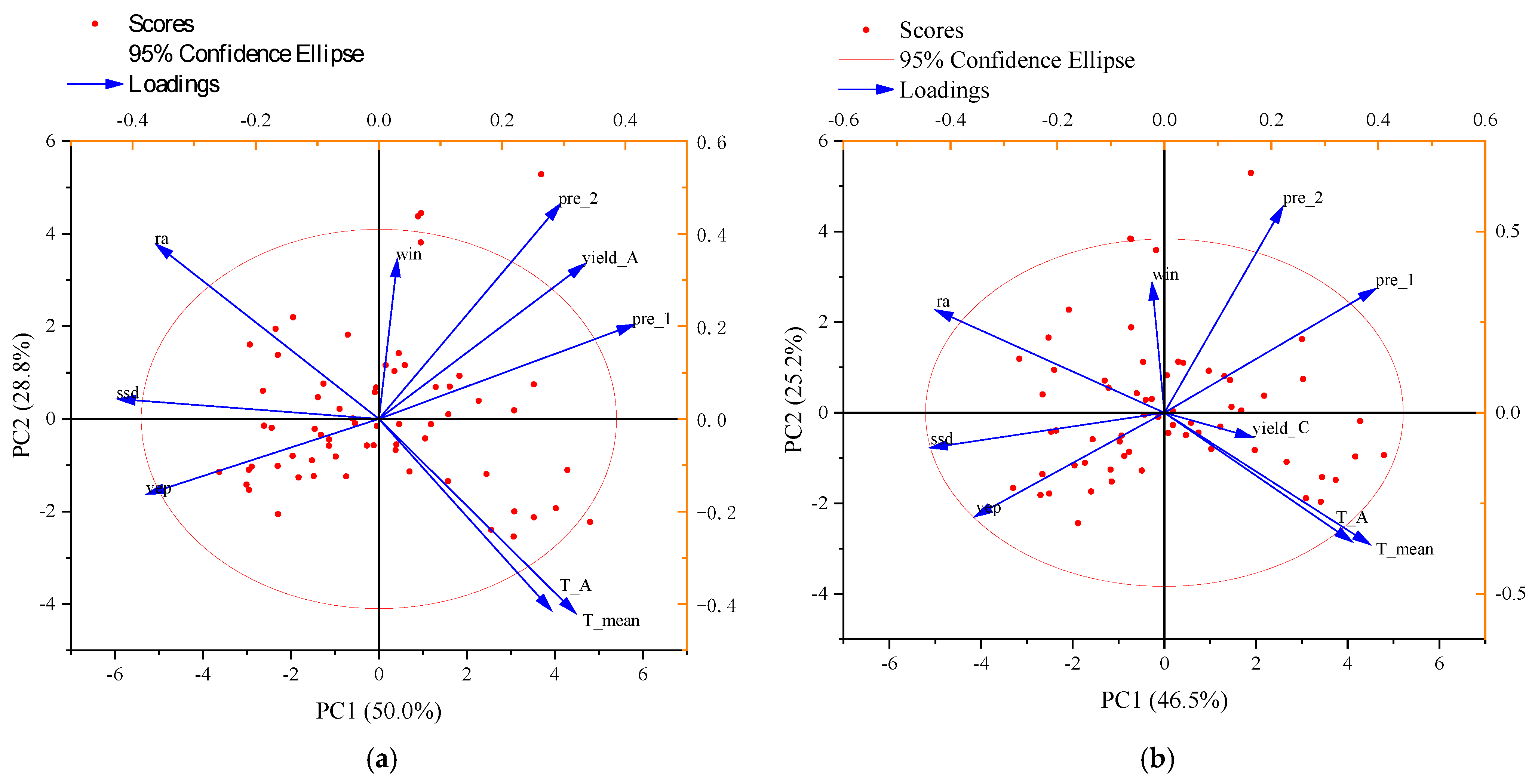
| Cultivars | Planting Area | Parameter | Value |
|---|---|---|---|
| Xifeng 24 | Gansu; Qinghai; Ningxia | vern_sens photop_sens potential_grain_filling_rate tt_start_grain_fill tt_end_grain_fill tt_startgf_to_mat | 2 2.0 0.0025 617.5 32.5 650 |
| Changwu 89134 | Gansu; Qinghai | vern_sens photop_sens potential_grain_filling_rate tt_start_grain_fill tt_end_grain_fill tt_flowering | 2 3.0 0.0025 545 35 120 1.9 |
| Xiaoyan 22 | Shannxi; Henan | vern_sens photop_sens potential_grain_filling_rate grain_per_gram_stem max_ grain_size | 1.9 3.0 0.0035 26 0.042 |
| Jinmai 47 | Shanxi; Inner Mongolia | vern_sens photop_sens tt_floral_initiation tt_end_of_juvenile tt_end_grain_fill tt_flowering | 4.0 2.8 414.5 426.6 570.8 92.8 |
| SSP-RCP | Age | Precipitation (mm) | STDEV | Total Solar Radiation (102 MJ)/(m2·d) | STDEV | Mean Temperature (°C) | STDEV |
|---|---|---|---|---|---|---|---|
| SSP2-4.5 | 2030s | 202.14 | 16.83 | 37.19 | 0.39 | 6.73 | 0.21 |
| 2050s | 189.75 | 15.10 | 36.70 | 0.37 | 7.08 | 0.19 | |
| 2080s | 186.21 | 15.66 | 36.36 | 0.41 | 7.33 | 0.18 | |
| SSP5-8.5 | 2030s | 197.85 | 22.29 | 36.72 | 0.55 | 6.85 | 0.21 |
| 2050s | 186.81 | 26.73 | 34.83 | 0.78 | 7.57 | 0.27 | |
| 2080s | 174.77 | 21.17 | 33.12 | 0.73 | 8.35 | 0.29 |
| Province (Numbers of Sites) | SSP | Yield-Rainfed | |||
|---|---|---|---|---|---|
| Average Yield | Yield-cv | Yield Difference | cv Difference | ||
| Inner Mongolia (7) | Current | 2813.14 | 0.21 | 250.54 | 0.05 |
| S245 | 3452.01 | 0.20 | 413.96 | 0.02 | |
| S585 | 3516.58 | 0.21 | 390.23 | 0.02 | |
| Ningxia (9) | Current | 3339.34 | 0.17 | 695.91 | 0.01 |
| S245 | 4381.35 | 0.18 | 986.17 | 0.03 | |
| S585 | 4441.20 | 0.20 | 952.33 | 0.03 | |
| Shaanxi (11) | Current | 4087.19 | 0.14 | 1456.48 | 0.03 |
| S245 | 5153.72 | 0.14 | 1335.19 | 0.05 | |
| S585 | 5062.22 | 0.14 | 1270.13 | 0.05 | |
| Shanxi (12) | Current | 3275.60 | 0.16 | 568.16 | 0.04 |
| S245 | 4382.86 | 0.17 | 764.25 | 0.03 | |
| S585 | 4382.45 | 0.17 | 688.77 | 0.03 | |
| Qinghai (5) | Current | 4230.67 | 0.16 | 529.25 | 0.02 |
| S245 | 4878.51 | 0.14 | 460.99 | 0.01 | |
| S585 | 4984.50 | 0.14 | 451.66 | 0.00 | |
| Gansu (11) | Current | 4033.72 | 0.14 | 1517.55 | 0.03 |
| S245 | 4908.87 | 0.14 | 1717.08 | 0.02 | |
| S585 | 4929.57 | 0.15 | 1595.06 | 0.03 | |
| Henan (1) | Current | 4672.99 | 0.10 | 554.57 | 0.03 |
| S245 | 5331.26 | 0.09 | 1005.51 | 0.00 | |
| S585 | 5428.96 | 0.11 | 755.97 | 0.01 | |
Disclaimer/Publisher’s Note: The statements, opinions and data contained in all publications are solely those of the individual author(s) and contributor(s) and not of MDPI and/or the editor(s). MDPI and/or the editor(s) disclaim responsibility for any injury to people or property resulting from any ideas, methods, instructions or products referred to in the content. |
© 2024 by the authors. Licensee MDPI, Basel, Switzerland. This article is an open access article distributed under the terms and conditions of the Creative Commons Attribution (CC BY) license (https://creativecommons.org/licenses/by/4.0/).
Share and Cite
Wang, D.; Guo, M.; Li, J.; Wu, S.; Cheng, Y.; Shi, L.; Liu, S.; Ge, J.; Dong, Q.; Li, Y.; et al. Impact of Climate Change on the Winter Wheat Productivity Under Varying Climate Scenarios in the Loess Plateau: An APSIM Analysis (1961–2100). Agronomy 2024, 14, 2609. https://doi.org/10.3390/agronomy14112609
Wang D, Guo M, Li J, Wu S, Cheng Y, Shi L, Liu S, Ge J, Dong Q, Li Y, et al. Impact of Climate Change on the Winter Wheat Productivity Under Varying Climate Scenarios in the Loess Plateau: An APSIM Analysis (1961–2100). Agronomy. 2024; 14(11):2609. https://doi.org/10.3390/agronomy14112609
Chicago/Turabian StyleWang, Donglin, Mengjing Guo, Jipo Li, Siyu Wu, Yuhan Cheng, Longfei Shi, Shaobo Liu, Jiankun Ge, Qinge Dong, Yi Li, and et al. 2024. "Impact of Climate Change on the Winter Wheat Productivity Under Varying Climate Scenarios in the Loess Plateau: An APSIM Analysis (1961–2100)" Agronomy 14, no. 11: 2609. https://doi.org/10.3390/agronomy14112609
APA StyleWang, D., Guo, M., Li, J., Wu, S., Cheng, Y., Shi, L., Liu, S., Ge, J., Dong, Q., Li, Y., Wu, F., & Jiang, T. (2024). Impact of Climate Change on the Winter Wheat Productivity Under Varying Climate Scenarios in the Loess Plateau: An APSIM Analysis (1961–2100). Agronomy, 14(11), 2609. https://doi.org/10.3390/agronomy14112609







